
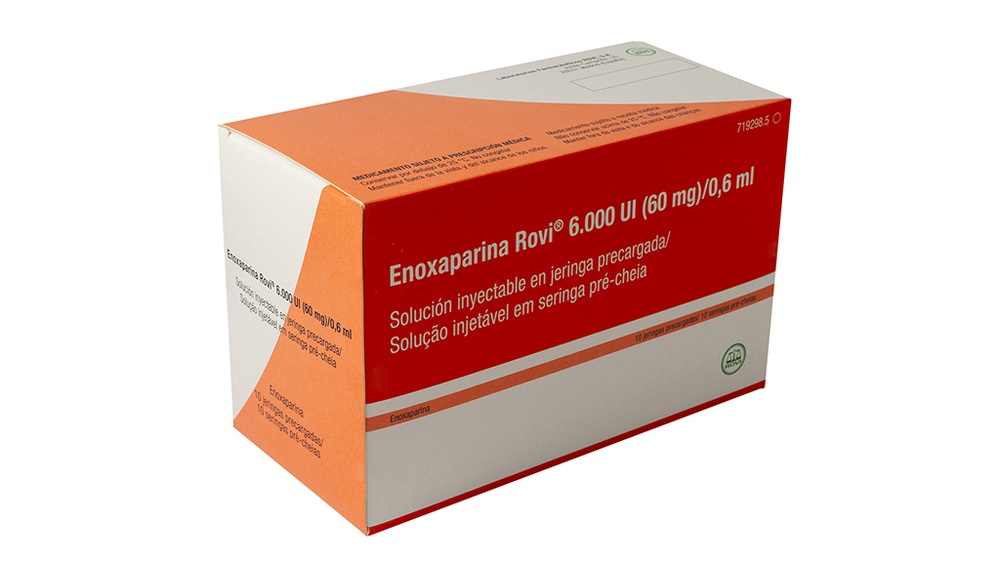
ЕНОКСАПАРИН РОВІ 6000 МО (60 мг)/0,6 мл РОЗЧИН ДЛЯ ІН'ЄКЦІЙ У ПЕРЕДНАПОВНЕНИХ ШПРИЦАХ

Запитайте лікаря про рецепт на ЕНОКСАПАРИН РОВІ 6000 МО (60 мг)/0,6 мл РОЗЧИН ДЛЯ ІН'ЄКЦІЙ У ПЕРЕДНАПОВНЕНИХ ШПРИЦАХ

Інструкція із застосування ЕНОКСАПАРИН РОВІ 6000 МО (60 мг)/0,6 мл РОЗЧИН ДЛЯ ІН'ЄКЦІЙ У ПЕРЕДНАПОВНЕНИХ ШПРИЦАХ
Вступ
Опис: інформація для користувача
Еноксапарин Рові 6 000 ОД (60 мг)/0,6 мл розчин для ін'єкцій у попередньо наповненому шприці
еноксапарин натрію
Всією увагою прочитайте цей опис перед початком використання цього лікарського засобу, оскільки він містить важливу інформацію для вас.
- Збережіть цей опис, оскільки вам може знадобитися знову його прочитати.
- Якщо у вас виникли питання, проконсультуйтеся з вашим лікарем, фармацевтом або медсестрою.
- Цей лікарський засіб призначений тільки для вас і не слід давати його іншим людям, навіть якщо вони мають相同ні симптоми, оскільки це може нашкодити їм.
- Якщо ви відчуваєте побічні ефекти, проконсультуйтеся з вашим лікарем або фармацевтом, навіть якщо це стосується побічних ефектів, які не вказані в цьому описі. Див. розділ 4.
Зміст опису
- Що таке Еноксапарин Рові і для чого він використовується
- Що потрібно знати перед початком використання Еноксапарину Рові
- Як використовувати Еноксапарин Рові
- Можливі побічні ефекти
- Зберігання Еноксапарину Рові
- Зміст упаковки та додаткова інформація
1. Що таке Еноксапарин Рові і для чого він використовується
Еноксапарин Рові містить активну речовину під назвою еноксапарин натрію, яка є низькомолекулярною гепарином (НМГ).
Еноксапарин Рові діє двома способами:
- Запобігає зростанню вже існуючих кров'яних згустків. Це допомагає вашому організмові розчинити їх і не давати їм подальшої шкоди.
- Перешкоджає утворенню кров'яних згустків у крові.
Еноксапарин Рові можна використовувати для:
- Лікування кров'яних згустків.
- Запобігання утворенню кров'яних згустків у крові в наступних ситуаціях:
- До і після хірургічної операції.
- Коли у вас є гостра хвороба і вам потрібно пережити період обмеженої рухливості.
- Якщо у вас був кров'яний згусток через рак, для профілактики утворення нових згустків.
- Коли у вас є нестабільна ангіна (хвороба, при якій не вистачає крові до серця).
- Після інфаркту міокарда.
- Запобігання утворенню кров'яних згустків у трубках апарату для діалізу (який використовується у людей з тяжкими проблемами нирок).
2. Що потрібно знати перед початком використання Еноксапарину Рові
Не використовуйте Еноксапарин Рові
- Якщо ви алергічні на еноксапарин натрію або на будь-які інші компоненти цього лікарського засобу (перелічені в розділі 6). Ознаки алергічної реакції включають: висип, проблеми з ковтанням або диханням, набряк губ, обличчя, горла або язика.
- Якщо ви алергічні на гепарин або інші низькомолекулярні гепарини, такі як надропарин, тінзапарин або далтепарин.
- Якщо у вас була реакція на гепарин, яка викликала сильне зниження кількості клітин, що беруть участь у згортанні крові (тромбоцитів) — ця реакція називається гепарин-індукованою тромбоцитопенією — протягом останніх 100 днів або якщо у вас є антитіла проти еноксапарину в крові.
- Якщо ви сильно кровоточите або маєте захворювання з високим ризиком кровотечі (такі як виразка шлунка, недавня операція на очах або мозку), включаючи недавній геморагічний інсульт.
- Якщо ви використовуєте Еноксапарин Рові для лікування кров'яних згустків і плануєте отримати спінальну або епідуральну анестезію або лумбальну пункцію протягом 24 годин.
Попередження та застереження
Еноксапарин Рові не слід заміняти іншими лікарськими засобами групи низькомолекулярних гепаринів. Це пов'язано з тим, що вони не є ідентичними і не мають однакової активності та інструкцій використання.
Проконсультуйтеся з вашим лікарем або фармацевтом перед початком використання Еноксапарину Рові, якщо:
- колись у вас була реакція на гепарин, яка викликала сильне зниження кількості тромбоцитів
- ви плануєте отримати спінальну/лумбальну анестезію або лумбальну пункцію (див. «Хірургічні операції та анестезія»): слід дотримуватися затримки між Еноксапарином Рові та використанням цього процедури
- вам імплантовано клапан серця
- у вас є ендокардит (інфекція внутрішнього шару серця)
- у вас є анамнез виразки шлунка
- ви недавно мали інсульт (геморагічний інсульт)
- у вас підвищений артеріальний тиск
- у вас є цукровий діабет або проблеми з судинами очей, викликані цукровим діабетом (ретинопатія)
- ви недавно мали операцію на очах або мозку
- ви є людиною похилого віку (понад 65 років) і особливо якщо вам більше 75 років
- у вас є проблеми з нирками
- у вас є проблеми з печінкою
- у вас дуже низька вага або ви маєте надмірну вагу
- у вас підвищений рівень калію в крові (що можна перевірити за допомогою аналізу крові)
- ви зараз використовуєте лікарські засоби, які впливають на кровотечу (див. нижче - Використання Еноксапарину Рові з іншими лікарськими засобами).
Вам може знадобитися проведення аналізу крові перед початком використання цього лікарського засобу та під час його використання; це для перевірки рівня тромбоцитів і рівня калію в крові.
Діти та підлітки
Безпека та ефективність еноксапарину не були оцінені у дітей та підлітків.
Використання Еноксапарину Рові з іншими лікарськими засобами
Повідомте вашому лікареві або фармацевту, якщо ви використовуєте, недавно використовували або можете використовувати інші лікарські засоби.
- Варфарин - використовується для зниження згортання крові
- Аспірин (також відомий як ацетилсаліцилова кислота або АСК), клопідогрел або інші лікарські засоби, які використовуються для переривання утворення кров'яних згустків у крові (див. також розділ 3, «Зміна антикоагулянтної терапії»)
- Декстрани - використовуються як замінники крові
- Ібупрофен, диклофенак, кеторолак та інші лікарські засоби, відомі як нестероїдні протизапальні засоби, які використовуються для лікування болю та запалення при артриті та інших захворюваннях
- Преднізолон, дексаметазон та інші лікарські засоби, які використовуються для лікування астми, ревматоїдного артриту та інших захворювань
- Лікарські засоби, які підвищують рівень калію в крові, такі як солі калію, діуретики та деякі лікарські засоби для лікування серцевих захворювань.
Хірургічні операції та анестезія
У разі проведення лумбальної пункції або хірургічної операції, під час якої буде використовуватися спінальна або епідуральна анестезія, повідомте вашому лікареві, що ви використовуєте Еноксапарин Рові. Див. «Використання Еноксапарину Рові з іншими лікарськими засобами». Також повідомте вашому лікареві, якщо у вас є проблеми з хребтом або якщо ви раніше мали операцію на хребті.
Вагітність та лактація
Якщо ви вагітні, вважаєте, що можете бути вагітні або плануєте завагітніти, проконсультуйтеся з вашим лікарем або фармацевтом перед використанням цього лікарського засобу.
Якщо ви вагітні та маєте механічний клапан серця, ви можете мати підвищений ризик утворення кров'яних згустків. Ваш лікар обговорить це питання з вами.
Якщо ви перебуваєте в період лактації або плануєте годувати грудьми, вам слід проконсультуватися з вашим лікарем перед використанням цього лікарського засобу.
Водіння транспортних засобів та використання машин
Еноксапарин Рові не впливає на здатність водити транспортні засоби та використовувати машини.
Рекомендується, щоб медичний працівник записав назву лікарського засобу та номер партії продукту, який ви використовуєте.
Еноксапарин Рові містить натрій
Цей лікарський засіб містить менше 23 мг натрію (1 ммоль) на дозу; тобто, він є «практично безнатрієвим».
3. Як використовувати Енокспарин Рові
Слідкуйте точно інструкціям щодо застосування цього лікарського засобу, вказаним вашим лікарем або фармацевтом. У разі сумнівів проконсультуйтеся знову з вашим лікарем або фармацевтом.
Застосування лікарського засобу
- Зазвичай ваш лікар або медсестра введуть Енокспарин Рові. Це тому, що його потрібно вводити за допомогою ін'єкції.
- Коли ви повернетесь додому, можливо, вам потрібно буде продовжувати використовувати Енокспарин Рові та вводити його самостійно (див. інструкції щодо того, як це зробити).
- Енокспарин Рові зазвичай вводять під шкіру (підшкірно).
- Енокспарин Рові можна вводити в ваші вени (внутрішньовенно) після певних типів серцевих нападів та хірургічних операцій.
- Енокспарин Рові можна додати до трубки, яка виходить з вашого тіла (артеріальної лінії), на початку сеансу діалізу.
Не вводьте Енокспарин Рові в м'яз (внутрішньом'язово).
Яку кількість буде введено
- Ваш лікар вирішить, яку кількість Енокспарину Рові буде введено. Кількість залежатиме від причини, з якою буде використовуватися лікарський засіб.
- Якщо у вас є проблеми з нирками, можливо, буде введено меншу кількість Енокспарину Рові.
- Лікування утворення кров'яних згустків:
- Звичайна доза становить 150 ОД (1,5 мг) на кілограм ваги тіла на день або 100 ОД (1 мг) на кілограм ваги тіла двічі на день.
- Ваш лікар вирішить, скільки часу ви будете приймати Енокспарин Рові.
- Перерване утворення кров'яних згустків у наступних ситуаціях:
Операції або періоди обмеженої рухливості через захворювання
- Доза залежатиме від ймовірності того, що у вас розвинеться кров'яний згорток. Буде введено 2000 ОД (20 мг) або 4000 ОД (40 мг) Енокспарину Рові на день.
- Якщо вам потрібно операція, зазвичай перша ін'єкція буде зроблена за 2 або 12 годин до операції.
- Якщо у вас обмежена рухливість через захворювання, зазвичай буде введено 4000 ОД (40 мг) Енокспарину Рові на день.
- Ваш лікар вирішить, скільки часу ви будете приймати Енокспарин Рові.
Після того, як у вас стався серцевий напад
Енокспарин Рові можна використовувати при двох різних типах серцевих нападів, які називаються ІАМЦЕСТ (інфаркт міокарда з підвищенням сегмента ST) або не ІАМЦЕСТ (ІАМСЕСТ). Кількість Енокспарину Рові, яка буде введена, залежатиме від вашого віку та типу серцевого нападу, який у вас стався.
Серцевий напад типу ІАМСЕСТ:
- Звичайна доза становить 100 ОД (1 мг) на кілограм ваги тіла кожні 12 годин.
- Зазвичай ваш лікар скаже вам також приймати аспірин (ацетилсаліцилову кислоту).
- Ваш лікар вирішить, скільки часу ви будете приймати Енокспарин Рові.
Серцевий напад типу ІАМЦЕСТ, якщо вам менше 75 років:
- Буде зроблена перша внутрішньовенна ін'єкція 3000 ОД (30 мг) Енокспарину Рові.
- Одночасно буде зроблена ін'єкція Енокспарину Рові під шкіру (підшкірна ін'єкція). Звичайна доза становить 100 ОД (1 мг) на кілограм ваги тіла кожні 12 годин.
- Зазвичай ваш лікар скаже вам також приймати аспірин (ацетилсаліцилову кислоту).
- Ваш лікар вирішить, скільки часу ви будете приймати Енокспарин Рові.
Серцевий напад типу ІАМЦЕСТ, якщо вам 75 років або більше:
- Звичайна доза становить 75 ОД (0,75 мг) на кілограм ваги тіла кожні 12 годин.
- Максимальна кількість Енокспарину Рові, яка буде введена у перші дві ін'єкції, становить 7500 ОД (75 мг).
- Ваш лікар вирішить, скільки часу ви будете приймати Енокспарин Рові.
Для пацієнтів, які проходять коронарне стентування:
Відповідно до того, коли була зроблена остання ін'єкція Енокспарину Рові, ваш лікар може вирішити зробити додаткову ін'єкцію Енокспарину Рові перед коронарним стентуванням. Це буде зроблено внутрішньовенно.
- Перерване утворення кров'яних згустків у трубках апарату діалізу:
- Звичайна доза становить 100 ОД (1 мг) на кілограм ваги тіла.
- Енокспарин Рові додається до трубки, яка виходить з вашого тіла (артеріальної лінії), на початку сеансу діалізу. Ця кількість зазвичай достатня для сеансу тривалістю 4 години. Однак ваш лікар може зробити повторну ін'єкцію 50 ОД до 100 ОД (0,5 мг до 1 мг) на кілограм ваги тіла, якщо це буде необхідно.
Інструкції щодо використання шприца
Якщо ви будете вводити собі Енокспарин Рові самостійно
Якщо ви можете вводити собі Енокспарин Рові самостійно, ваш лікар або медсестра покажуть вам, як це зробити. Не намагайтесь вводити собі самостійно, якщо вам не показали, як це зробити. Якщо ви не знаєте, що робити, негайно проконсультуйтеся з вашим лікарем або медсестрою. Якщо ін'єкція буде зроблена під шкіру правильно (що називається "підшкірною ін'єкцією"), це допоможе зменшити біль і гематому в місці ін'єкції.
Перед тим, як ви введете собі Енокспарин Рові
Підготовьте все, що вам потрібно: шприц, шматок вати з алкоголем або мильним розчином, і контейнер для колючих предметів.
Перевірте термін придатності лікарського засобу. Якщо він закінчився, не використовуйте його.
Перевірте, чи не пошкоджений шприц, і чи є розчин лікарського засобу прозорим. Якщо ні, використайте інший шприц.
Перевірте, чи знаєте ви, яку кількість лікарського засобу потрібно вводити.
Перегляньте місце ін'єкції на вашому животі, чи не залишилося червоного кольору, зміни кольору шкіри, набухання, гноjenя або болю, який ще зберігається. Якщо це трапилося, проконсультуйтеся з вашим лікарем або медсестрою.
Інструкції щодо введення собі Енокспарину Рові:
(Інструкції для шприців без системи безпеки)
Підготовка місця ін'єкції
- Виберіть місце на правій або лівій стороні вашого живота. Відстань не менше 5 см від пупка і в будь-якому напрямку.
Не вводьте ін'єкцію всередині 5 см навколо вашого пупка або навколо нього, якщо є шрами або гематоми.
Для ін'єкції чергуйте ліву та праву сторони вашого живота, залежно від того, де була зроблена остання ін'єкція.

- Вимийте руки. Очистіть (не тертьте) місце ін'єкції шматком вати з алкоголем або мильним розчином.
- Сидіть або лежіть у зручній позиції, щоб бути розслабленим. Перевірте, чи можете ви бачити місце ін'єкції. Найкраще це зробити на дивані, кріслі-качалці або в ліжку з подушками.
Вибір дози
- Акуратно зніміть ковпачок з голки шприца, потягнувши його. Вийміть ковпачок.
Перед тим, як ви введете собі ін'єкцію, не натискайте на поршень, щоб видалити повітряні бульки. Це може призвести до втрати лікарського засобу.
Після того, як ви знімете ковпачок, нічого не торкайтеся голкою. Це забезпечить, що голка залишається чистою (стерильною).
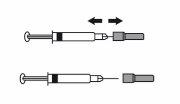
- Коли кількість лікарського засобу в шприці збігається з дозою, яку вам призначили, немає потреби регулювати дозу. Тепер ви готові до ін'єкції.
- Коли доза залежить від вашої ваги тіла, вам, можливо, потрібно буде регулювати дозу в шприці, щоб вона збігалася з призначеною дозою. У цьому випадку ви можете видалити надлишок лікарського засобу, тримаючи шприц вниз (щоб утримувати повітряну бульку в шприці) і видалити надлишок в контейнер.
- Можливо, на кінці голки з'явиться крапля. Якщо це трапилося, потрібно видалити краплю перед ін'єкцією, давши легкі поштовхи шприцу з голкою, спрямованою вниз. Тепер ви готові до ін'єкції.
Введення ін'єкції
- Тримайте шприц рукою, якою ви пишете (як би це був олівець). Іншою рукою пійміть м'яко місце ін'єкції на вашому животі між вказівним пальцем і великим пальцем, щоб утворити складку на шкірі.
Перевірте, чи утримуєте цю складку шкіри протягом усього часу ін'єкції.
- Тримайте шприц так, щоб голка була спрямована прямо вниз (вертикально під кутом 90 градусів). Введіть всю голку в складку шкіри.
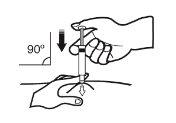
- Натискайте на поршень великим пальцем. Це введе лікарський засіб у жирову тканину вашого живота. Завершите ін'єкцію, використовуючи весь лікарський засіб у шприці.
- Видаліть голку з місця ін'єкції, потягнувши її прямо. Направьте голку від себе та інших людей. Тепер ви можете звільнити складку шкіри.
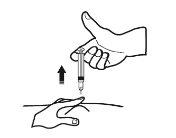
Після закінчення ін'єкції
- Щоб уникнути гематоми, не тертьте місце ін'єкції після ін'єкції.
- Помістіть використаний шприц у контейнер для колючих предметів. Закрийте кришку контейнера та помістіть контейнер поза зоною досяжності дітей. Коли контейнер буде повний, видаліть його так, як вказав ваш лікар або фармацевт.
Видалення незастосованого лікарського засобу та всіх матеріалів, які були в контакті з ним, буде здійснено згідно з місцевими правилами.
Якщо ви вважаєте, що доза надто висока (наприклад, якщо у вас виникла непередбачувана кровотеча) або надто низька (наприклад, якщо доза не здається ефективною), негайно проконсультуйтеся з вашим лікарем або фармацевтом.
Інструкції для шприців із системою безпеки:
Підготовка місця ін'єкції
- Виберіть місце на правій або лівій стороні вашого живота. Відстань не менше 5 см від пупка і в будь-якому напрямку.
Не вводьте ін'єкцію всередині 5 см навколо вашого пупка або навколо нього, якщо є шрами або гематоми.
Для ін'єкції чергуйте ліву та праву сторони вашого живота, залежно від того, де була зроблена остання ін'єкція.

- Вимийте руки. Очистіть (не тертьте) місце ін'єкції шматком вати з алкоголем або мильним розчином.
- Сидіть або лежіть у зручній позиції, щоб бути розслабленим. Перевірте, чи можете ви бачити місце ін'єкції. Найкраще це зробити на дивані, кріслі-качалці або в ліжку з подушками.
Вибір дози
- Акуратно зніміть ковпачок з голки шприца, потягнувши його. Вийміть ковпачок.
Перед тим, як ви введете собі ін'єкцію, не натискайте на поршень, щоб видалити повітряні бульки. Це може призвести до втрати лікарського засобу.
Після того, як ви знімете ковпачок, нічого не торкайтеся голкою. Це забезпечить, що голка залишається чистою (стерильною).
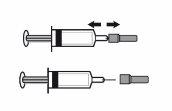
- Коли кількість лікарського засобу в шприці збігається з дозою, яку вам призначили, немає потреби регулювати дозу. Тепер ви готові до ін'єкції.
- Коли доза залежить від вашої ваги тіла, вам, можливо, потрібно буде регулювати дозу в шприці, щоб вона збігалася з призначеною дозою. У цьому випадку ви можете видалити надлишок лікарського засобу, тримаючи шприц вниз (щоб утримувати повітряну бульку в шприці) і видалити надлишок в контейнер.
- Можливо, на кінці голки з'явиться крапля. Якщо це трапилося, потрібно видалити краплю перед ін'єкцією, давши легкі поштовхи шприцу з голкою, спрямованою вниз. Тепер ви готові до ін'єкції.
Введення ін'єкції
- Тримайте шприц рукою, якою ви пишете (як би це був олівець). Іншою рукою пійміть м'яко місце ін'єкції на вашому животі між вказівним пальцем і великим пальцем, щоб утворити складку на шкірі.
Перевірте, чи утримуєте цю складку шкіри протягом усього часу ін'єкції.
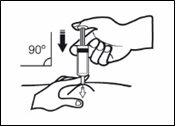 Тримайте шприц так, щоб голка була спрямована прямо вниз (вертикально під кутом 90 градусів). Введіть всю голку в складку шкіри.
Тримайте шприц так, щоб голка була спрямована прямо вниз (вертикально під кутом 90 градусів). Введіть всю голку в складку шкіри.
- Натискайте на поршень великим пальцем. Це введе лікарський засіб у жирову тканину вашого живота. Завершите ін'єкцію, використовуючи весь лікарський засіб у шприці.
- Видаліть голку з місця ін'єкції, потягнувши її прямо, і тримаючи палець на поршні. Голка повинна бути спрямована від вас та інших людей. Система безпеки буде активована при натисканні на поршень. Захисний чохол автоматично покриє голку і видасть чутний клік, який підтверджує активацію пристрою. Тепер ви можете звільнити складку шкіри.
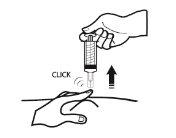
Після закінчення ін'єкції
- Щоб уникнути гематоми, не тертьте місце ін'єкції після ін'єкції.
- Помістіть використаний шприц у контейнер для колючих предметів. Закрийте кришку контейнера та помістіть контейнер поза зоною досяжності дітей. Коли контейнер буде повний, видаліть його так, як вказав ваш лікар або фармацевт.
Видалення незастосованого лікарського засобу та всіх матеріалів, які були в контакті з ним, буде здійснено згідно з місцевими правилами.
Якщо ви вважаєте, що доза надто висока (наприклад, якщо у вас виникла непередбачувана кровотеча) або надто низька (наприклад, якщо доза не здається ефективною), негайно проконсультуйтеся з вашим лікарем або фармацевтом.
Зміна антикоагулянтної терапії
- Зміна Енокспарину Рові на лікарські засоби для зменшення згортання крові, що називаються антагоністами вітаміну К (наприклад, варфарин)
Ваш лікар призначить аналіз крові на наявність параметра, що називається МНР, і скаже вам, коли потрібно припинити лікування Енокспарином Рові.
- Зміна лікарських засобів для зменшення згортання крові, що називаються антагоністами вітаміну К (наприклад, варфарин), на Енокспарин Рові
Припиніть використання антагоніста вітаміну К. Ваш лікар призначить аналіз крові на наявність параметра, що називається МНР, і скаже вам, коли потрібно почати використовувати Енокспарин Рові.
- Зміна Енокспарину Рові на пероральні антикоагулянти прямої дії
Припиніть використання Енокспарину Рові. Почніть приймати пероральний антикоагулянт прямої дії за 0-2 години до того, як вам потрібно буде зробити наступну ін'єкцію, і продовжуйте як зазвичай.
- Зміна перорального антикоагулянту прямої дії на Енокспарин Рові
Припиніть приймати пероральний антикоагулянт прямої дії. Не починайте лікування Енокспарином Рові до тих пір, поки не минуть 12 годин після останньої дози перорального антикоагулянту прямої дії.
Якщо ви використали більше Енокспарину Рові, ніж потрібно
Якщо ви вважаєте, що використали надто багато Енокспарину Рові або надто мало, негайно проконсультуйтеся з вашим лікарем, медсестрою або фармацевтом, навіть якщо ви не відчуваєте жодних проблем. Якщо дитина випадково ввела собі або проковтнула Енокспарин Рові, негайно доставьте її до відділення невідкладної допомоги лікарні.
У разі передозування або випадкового введення лікарського засобу негайно проконсультуйтеся з вашим лікарем або зверніться до відділення невідкладної допомоги лікарні, взявши з собою цей листок, або телефонуйте до служби токсикологічної інформації, телефон 91 562 04 20, вказуючи назву лікарського засобу та кількість, що була введена.
Якщо ви забули використати Енокспарин Рові
Якщо ви забули зробити ін'єкцію, зробіть її якнайшвидше, коли ви про це вспомните. Не використовуйте подвійну дозу в один і той же день, щоб компенсувати пропущені дози. Щоб вам не забути жодної дози, можете бути корисним використання щоденника.
Якщо ви припините лікування Енокспарином Рові
Якщо в вас є будь-які інші питання щодо використання цього лікарського засобу, проконсультуйтеся з вашим лікарем, фармацевтом або медсестрою.
Важливо, щоб ви продовжували приймати Енокспарин Рові до тих пір, поки ваш лікар не вирішить припинити лікування. Якщо ви припините лікування, може утворитися кров'яний згорток, що може бути дуже небезпечним.
4. Можливі побічні ефекти
Як і всі лікарські засоби, цей лікарський засіб може викликати побічні ефекти, хоча не всі люди їх відчувають.
Як і інші подібні лікарські засоби (лікарські засоби для зменшення кров'яних згустків), Еnoxaparina Rovi може викликати кровотечу, що потенційно може загрожувати вашому життю. В деяких випадках кровотеча може бути не очевидною.
Якщо ви помітите будь-який епізод кровотечі, який не зупиняється сам собою, або якщо ви помітите ознаки надмірної кровотечі (надмірна слабкість, втома, блідість, головокружіння, головний біль або необґрунтоване набухання) негайно проконсультуйтеся з вашим лікарем.
Ваш лікар може вирішити тримати вас під суворим спостереженням або змінити вашу медикаментозну терапію.
Перервіть лікування з еnoxaparinом і негайно повідомте вашому лікареві або медсестрі, якщо ви відчуваєте будь-які з наступних симптомів:
- Будь-які ознаки важкої алергічної реакції (такі як труднощі з диханням, набухання губ, рота, горла чи очей).
- Розповсюджена червона та луската висипка, з підшкірними вузлами та пухирями, супроводжувана лихоманкою. Симптоми зазвичай з'являються на початку лікування (пустулозна екзантема).
Ви повинні негайно повідомити вашому лікареві
- Якщо ви маєте будь-які ознаки блокування кров'яного судини кров'яним згустком, такі як:
- Біль, подібний до судом, червоність, тепло або набухання в одній з ваших ніг - це симптоми глибокої венозної тромбози.
- Труднощі з диханням, біль у грудях,失іння свідомості або кашель з кров'ю - це симптоми легеневого тромбоемболізму.
- Якщо у вас є болюча висипка з червоними точками під шкірою, які не зникають при натисненні.
Ваш лікар може замовити аналіз крові для перевірки кількості тромбоцитів.
Загальний перелік можливих побічних ефектів:
Дуже часті (можуть впливати на більше 1 з 10 осіб)
- Кровотеча.
- Збільшення активності печінкових ферментів.
Часті (можуть впливати до 1 з 10 осіб)
- Якщо з'являються синяки з більшою частотою, ніж зазвичай. Це може бути пов'язано з проблемами крові через низьку кількість тромбоцитів.
- Червоні плями на шкірі. Вони з'являються з більшою частотою в місці, де вам ввели Еnoxaparina Rovi.
- Висипка на шкірі (кропив'янка, уртикарія).
- Червоність і свербіж шкіри.
- Синяк або біль у місці ін'єкції.
- Зменшення кількості червоних кров'яних тільців у крові.
- Збільшення кількості тромбоцитів у крові.
- Головний біль.
Рідкі (можуть впливати до 1 з 100 осіб)
- Важкий раптовий головний біль. Це може бути ознакою кровотечі в мозку.
- Чувствливість до дотику та набухання живота. Це може бути ознакою гастрологічної кровотечі.
- Червоні та великі ушкодження шкіри, нерівномірної форми з або без пухирів.
- Ірритація шкіри (місцева ірритація).
- Ви можете помітити жовтівання шкіри чи очей, а також потемніння кольору сечі. Це може бути пов'язано з проблемами печінки.
Рідкісні (можуть впливати до 1 з 1 000 осіб)
- Важка алергічна реакція. Ознаки цієї реакції можуть включати: висипка на шкірі, проблеми з ковтанням чи диханням, набухання губ, обличчя, горла чи язика.
- Збільшення рівня калію в крові. Це більш ймовірно у людей з проблемами нирок чи цукровим діабетом. Ваш лікар може перевірити це шляхом аналізу крові.
- Збільшення кількості еозинофілів у крові. Ваш лікар може перевірити це шляхом аналізу крові.
- Випадіння волосся.
- Остеопороз (хвороба, при якій кістки можуть ламатися з більшою ймовірністю).
- Оніміння, слабкість і боль у м'язах (особливо в нижній частині тіла) після проведення лумбальної пункції чи спінальної анестезії.
- Втрата контролю над сечовим міхуром чи кишківником (так, що ви не можете контролювати свої потреби).
- Затвердіння чи вузол у місці ін'єкції.
Звітність про побічні ефекти
Якщо ви відчуваєте будь-який побічний ефект, проконсультуйтеся з вашим лікарем, фармацевтом чи медсестрою, навіть якщо це можливі побічні ефекти, які не перелічені в цьому листку. Ви також можете повідомити про них безпосередньо через Sistema Español de Farmacovigilancia de Medicamentos de Uso Humano: www.notificaRAM.es. Завдяки повідомленню про побічні ефекти ви можете допомогти надати більше інформації про безпеку цього лікарського засобу.
5. Зберігання Еnoxaparina Rovi
Зберігати при температурі нижче 25 °C. Не заморожувати.
Шприци з попередньо заповненим Еnoxaparina Rovi містять одну дозу; викиньте будь-який невикористаний продукт.
Тримайте цей лікарський засіб поза зором і досягненням дітей.
Не використовуйте цей лікарський засіб після закінчення терміну придатності, вказаного на упаковці після CAD. Термін придатності - останній день місяця, який вказано.
Не використовуйте цей лікарський засіб, якщо ви помітите, що шприц пошкоджений або продукт не є прозорим.
Лікарські засоби не повинні викидатися у водопровід чи сміття. Відкладайте упаковки та лікарські засоби, які вам не потрібні, у пункті збору фармацевтичних відходів. Спитайте вашого фармацевта, як позбутися упаковок та лікарських засобів, які вам вже не потрібні. Таким чином, ви допоможете захистити довкілля.
6. Зміст упаковки та додаткова інформація
Склад Еnoxaparina Rovi
- Активний інгредієнт - еnoxaparin содій.
Кожен шприц з попередньо заповненим містить еnoxaparin содій з анти-Xa активністю 6 000 ОД (еквівалентно 60 мг) у 0,6 мл води для ін'єкційних препаратів.
- Інші складові - вода для ін'єкційних препаратів.
Вигляд продукту та зміст упаковки
Enoxaparina Rovi - прозорий ін'єкційний розчин, безколірний або світло-жовтий, у шприці з попередньо заповненим склом типу I, оснащеному голкою для ін'єкції, з або без автоматичного пристрою безпеки. Він представлений наступним чином:
Enoxaparina Rovi 6 000 ОД (60 мг)/0,6 мл ін'єкційний розчин у шприці з попередньо заповненим, градуйованим на 1 мл.
Упаковки по 2, 6, 10, 12, 20, 24, 30 та 50 шприців.
Можливо, тільки деякі розміри упаковок будуть реалізовані.
У деяких розмірах упаковок шприц з попередньо заповненим може бути представлений у поєднанні з пристроєм безпеки.
Власник авторизації на розміщення на ринку та відповідальна особа за виробництво
Власник авторизації на розміщення на ринку
Laboratorios Farmacéuticos ROVI, S.A.
Julián Camarillo, 35
28037 - Madrid. España
Відповідальна особа за виробництво
ROVI Pharma Industrial Services, S.A.
Julián Camarillo, 35
28037 - Madrid. España
Цей лікарський засіб авторизований у країнах-членах Європейського економічного простору та у Великій Британії (Північній Ірландії) під наступними назвами:
Австрія, Данія, Фінляндія, Німеччина, Норвегія, Швеція: Enoxaparin Becat
Італія, Іспанія, Португалія: Enoxaparina Rovi
Бельгія, Франція, Люксембург, Нідерланди: Enoxaparine Becat
Греція: Enoxaparin Rovi
Словенія: Enoksaparin Rovi
Болгарія, Чехія, Естонія, Хорватія, Угорщина, Латвія, Польща, Румунія, Словаччина: Losmina
Ірландія, Велика Британія (Північна Ірландія): Arovi
Дата останнього перегляду цього листка:Січень 2025
Інші джерела інформації
Детальна інформація про цей лікарський засіб доступна на сайті Агенції з лікарських засобів та медичних продуктів Іспанії (AEMPS) (http://www.aemps.gob.es/)

Скільки коштує ЕНОКСАПАРИН РОВІ 6000 МО (60 мг)/0,6 мл РОЗЧИН ДЛЯ ІН'ЄКЦІЙ У ПЕРЕДНАПОВНЕНИХ ШПРИЦАХ в Іспанії у 2025 році?
ЕНОКСАПАРИН РОВІ 6000 МО (60 мг)/0,6 мл РОЗЧИН ДЛЯ ІН'ЄКЦІЙ У ПЕРЕДНАПОВНЕНИХ ШПРИЦАХ коштує в середньому 54.34 євро у грудень, 2025 році. Ціна може змінюватися залежно від регіону, аптеки та наявності рецепта. Рекомендуємо перевіряти актуальну вартість у місцевих аптеках або через онлайн-сервіси.
- Країна реєстрації
- Середня ціна в аптеках54.34 EUR
- Діючі речовини
- Потрібен рецептТак
- Виробник
- Інформація є довідковою і не є медичною порадою. Перед прийомом будь-яких препаратів обов'язково проконсультуйтеся з лікарем. Oladoctor не несе відповідальності за медичні рішення, прийняті на основі цього контенту.
- Альтернативи до ЕНОКСАПАРИН РОВІ 6000 МО (60 мг)/0,6 мл РОЗЧИН ДЛЯ ІН'ЄКЦІЙ У ПЕРЕДНАПОВНЕНИХ ШПРИЦАХФорма випуску: РОЗЧИН ДЛЯ ІН'ЄКЦІЙ, 100 мг (10000 МО) еноксапарину натрію/млДіючі речовини: enoxaparinВиробник: Sanofi Aventis S.A.Потрібен рецептФорма випуску: РОЗЧИН ДЛЯ ІН'ЄКЦІЙ, 120 мг (12000 МО) /0,8 млДіючі речовини: enoxaparinВиробник: Sanofi Aventis S.A.Потрібен рецептФорма випуску: РОЗЧИН ДЛЯ ІН'ЄКЦІЙ, 150 мг (15000 МО) /1 млДіючі речовини: enoxaparinВиробник: Sanofi Aventis S.A.Потрібен рецепт
Аналоги ЕНОКСАПАРИН РОВІ 6000 МО (60 мг)/0,6 мл РОЗЧИН ДЛЯ ІН'ЄКЦІЙ У ПЕРЕДНАПОВНЕНИХ ШПРИЦАХ в інших країнах
Найкращі аналоги з тією самою діючою речовиною та терапевтичним ефектом.
Аналог ЕНОКСАПАРИН РОВІ 6000 МО (60 мг)/0,6 мл РОЗЧИН ДЛЯ ІН'ЄКЦІЙ У ПЕРЕДНАПОВНЕНИХ ШПРИЦАХ у Польща
Аналог ЕНОКСАПАРИН РОВІ 6000 МО (60 мг)/0,6 мл РОЗЧИН ДЛЯ ІН'ЄКЦІЙ У ПЕРЕДНАПОВНЕНИХ ШПРИЦАХ у Україна
Лікарі онлайн щодо ЕНОКСАПАРИН РОВІ 6000 МО (60 мг)/0,6 мл РОЗЧИН ДЛЯ ІН'ЄКЦІЙ У ПЕРЕДНАПОВНЕНИХ ШПРИЦАХ
Консультація щодо дозування, побічних ефектів, взаємодій, протипоказань та поновлення рецепта на ЕНОКСАПАРИН РОВІ 6000 МО (60 мг)/0,6 мл РОЗЧИН ДЛЯ ІН'ЄКЦІЙ У ПЕРЕДНАПОВНЕНИХ ШПРИЦАХ – за рішенням лікаря та згідно з місцевими правилами.














